
Aimery of Lusignan, erroneously referred to as Amalric or Amaury in earlier scholarship, was the first King of Cyprus, reigning from 1196 to his death. He also reigned as the King of Jerusalem from his marriage to Isabella I in 1197 to his death. He was a younger son of Hugh VIII of Lusignan, a nobleman in Poitou. After participating in a rebellion against Henry II of England in 1168, he went to the Holy Land and settled in the Kingdom of Jerusalem.

The Kingdom of Jerusalem, also known as the Latin Kingdom, was a Crusader state that was established in the Levant immediately after the First Crusade. It lasted for almost two hundred years, from the accession of Godfrey of Bouillon in 1099 until the fall of Acre in 1291. Its history is divided into two periods with a brief interruption in its existence, beginning with its collapse after the siege of Jerusalem in 1187 and its restoration after the Third Crusade in 1192.

Year 1187 (MCLXXXVII) was a common year starting on Thursday of the Julian calendar.

The Battle of Hattin took place on 4 July 1187, between the Crusader states of the Levant and the forces of the Ayyubid sultan Saladin. It is also known as the Battle of the Horns of Hattin, due to the shape of the nearby extinct volcano of that name.

The Crusader states, or Outremer, were four Catholic polities that existed in the Levant from 1098 to 1291. Following the principles of feudalism, the foundation for these polities was laid by the First Crusade, which was proclaimed by the Latin Church in 1095 in order to reclaim the Holy Land after it was lost to the 7th-century Muslim conquest. Situated on the Eastern Mediterranean, the four states were, in order from north to south: the County of Edessa (1098–1150), the Principality of Antioch (1098–1268), the County of Tripoli (1102–1289), and the Kingdom of Jerusalem (1099–1291). The three northern states covered an area in what is now southeastern Turkey, northwestern Syria, and northern Lebanon; and the Kingdom of Jerusalem, the southernmost and most prominent state, covered an area in what is now Israel, the State of Palestine, southern Lebanon, and western Jordan. The description "Crusader states" can be misleading, as from 1130 onwards, very few people among the Franks were Crusaders. Medieval and modern writers use the term "Outremer" as a synonym, derived from the French word for overseas.
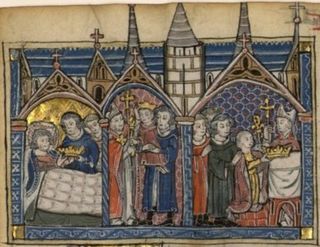
Raymond III was count of Tripoli from 1152 to 1187. He was a minor when Nizari Assassins murdered his father, Raymond II of Tripoli. Baldwin III of Jerusalem, who was staying in Tripoli, made Raymond's mother, Hodierna of Jerusalem, regent. Raymond spent the following years at the royal court in Jerusalem. He reached the age of majority in 1155, after which he participated in a series of military campaigns against Nur ad-Din, the Zengid ruler of Damascus. In 1161 he hired pirates to pillage the Byzantine coastline and islands to take vengeance on Byzantine emperor Manuel I Komnenos, who had refused to marry his sister Melisende. He was captured in the Battle of Harim by Nur ad-Din's troops on 10 August 1164, and imprisoned in Aleppo for almost ten years. During his captivity, Amalric I of Jerusalem administered the county of Tripoli on his behalf.

Sibylla was the queen of Jerusalem from 1186 to 1190. She reigned alongside her husband Guy of Lusignan, to whom she was unwaveringly attached despite his unpopularity among the barons of the Kingdom of Jerusalem.
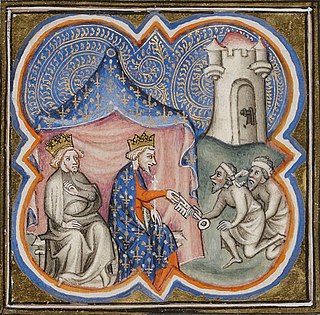
The siege of Acre was the first significant counterattack by Guy of Jerusalem against Saladin, leader of the Muslims in Syria and Egypt. This pivotal siege formed part of what later became known as the Third Crusade. The siege lasted from August 1189 until July 1191, in which time the city's coastal position meant the attacking Latin force were unable to fully invest the city and Saladin was unable to fully relieve it with both sides receiving supplies and resources by sea. Finally, it was a key victory for the Crusaders and a serious setback for Saladin's ambition to destroy the Crusader states.

The Battle of Montgisard was fought between the Kingdom of Jerusalem and the Ayyubid Dynasty on 25 November 1177 at Montgisard, in the Levant between Ramla and Yibna. The 16-year-old Baldwin IV of Jerusalem, severely afflicted by leprosy, led outnumbered Christian forces against Saladin's troops in what became one of the most notable engagements of the Crusades. The Muslim Army was quickly routed and pursued for twelve miles. Saladin fled back to Cairo, reaching the city on 8 December, with only a tenth of his army. Muslim historians considered Saladin's defeat to be so severe that it was only redeemed by his victory ten years later at the battles of Cresson and Hattin and the Siege of Jerusalem in 1187. Saladin did defeat Baldwin IV in the Battle of Marj Ayyun and the Siege of Jacob’s Ford in 1179, only to be defeated by Baldwin again at the Battle of Belvoir Castle in 1182 and the Siege of Kerak in 1183.
Heraclius or Eraclius, was archbishop of Caesarea and Latin Patriarch of Jerusalem.
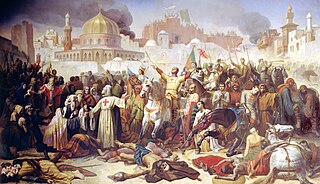
The siege of Jerusalem during the First Crusade lasted for one month and eight days, from 7 June 1099 to 15 July 1099. It was carried out by the Crusader army, which successfully captured Jerusalem from the Fatimid Caliphate and subsequently founded the Kingdom of Jerusalem. Having returned the city and the Church of the Holy Sepulchre to Christian rule, the siege was the final major armed engagement of the First Crusade, which had been proclaimed in 1095 to recover the Holy Land for the Christians in the context of the Muslim conquest. A number of eyewitness accounts of the battle were recorded, with the most quoted events being derived from the anonymous Latin-language chronicle Gesta Francorum.
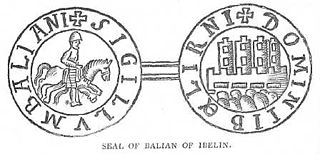
Balian of Ibelin, also known as Barisan the Younger, was a crusader noble of the Kingdom of Jerusalem in the 12th century. He was lord of Ibelin from 1170 to 1193. As the leader of the defense of the city during the siege of Jerusalem in 1187, he surrendered Jerusalem to Saladin on 2 October 1187.
John of Ibelin, called the Old Lord of Beirut, was a powerful crusader noble in the 13th century, one of the best known representatives of the influential Ibelin family. The son of Balian of Ibelin and the dowager queen Maria Comnena, he had close ties with the nobility of both Cyprus and Jerusalem, since he was the half-brother of Queen Isabella I of Jerusalem. Before he was 20, he was appointed constable of Jerusalem, and a few years later became lord of Beirut. John rebuilt Beirut after Saladin's conquest, and established the grand Ibelin family palace. He served as regent of Jerusalem on behalf of his niece Maria of Montferrat from 1205 to 1210 after her mother, Queen Isabella, died. He was also regent for Isabella's grandson Henry I of Cyprus from 1228 until Henry came of age in 1232. John was known as a principled man, and was seen as the natural leader of the Christian barons in the Holy Land. He resisted the power-seeking of Frederick II, Holy Roman Emperor, in Cyprus, and opposed the imperial forces until King Henry came of age.

Reginald Grenier was lord of Sidon and an important noble in the late-12th century Kingdom of Jerusalem.
Joscius was Archbishop of Tyre in the crusader Kingdom of Jerusalem in the late 12th century.
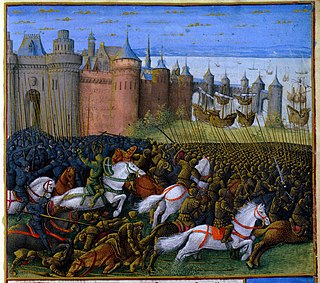
The siege of Tyre took place from 12 November 1187 to 1 January 1188. An army commanded by Saladin made an amphibious assault on the city, defended by Conrad of Montferrat. After two months of continuous struggle, Saladin dismissed his army and retreated to Acre.
The Treaty of Jaffa, more seldom referred to as the Treaty of Ramla or the treaty of 1192, was a truce agreed to during the Crusades. It was signed on 1 or 2 September 1192 A.D. between the Muslim ruler Saladin and Richard the Lionheart, King of England, shortly after the July–August 1192 Battle of Jaffa. The treaty, negotiated with the help of Balian of Ibelin, guaranteed a three-year truce between the two armies. This treaty ended the Third Crusade.

The History of Jerusalem during the Kingdom of Jerusalem began with the capture of the city by the Latin Christian forces at the apogee of the First Crusade. At that point it had been under Muslim rule for over 450 years. It became the capital of the Latin Kingdom of Jerusalem, until it was again conquered by the Ayyubids under Saladin in 1187. For the next forty years, a series of Christian campaigns, including the Third and Fifth Crusades, attempted in vain to retake the city, until Emperor Frederick II led the Sixth Crusade and successfully negotiated its return in 1229.
The Lordship of Tyre was a semi-independent domain in the Kingdom of Jerusalem from 1246 to 1291.

The timeline of the Kingdom of Jerusalem presents important events in the history of the Kingdom of Jerusalem—a Crusader state in modern day Israel and Jordan—in chronological order. The kingdom was established after the First Crusade in 1099. Its first ruler Godfrey of Bouillon did not take the title of king and swore fealty to the Latin Patriarch of Jerusalem, Daimbert. Godfrey's brother and successor Baldwin I was crowned the first king of Jerusalem without doing homage to the patriarch in 1100. By 1153, Baldwin I and his successors captured all towns on the Palestinian coast with the support of Pisan, Genoese and Venetian fleets and also took control of the caravan routes between Egypt and Syria. The kings regularly administered other crusader states—the Counties of Edessa and Tripoli and the Principality of Antioch—on behalf of their absent or underage rulers.

















